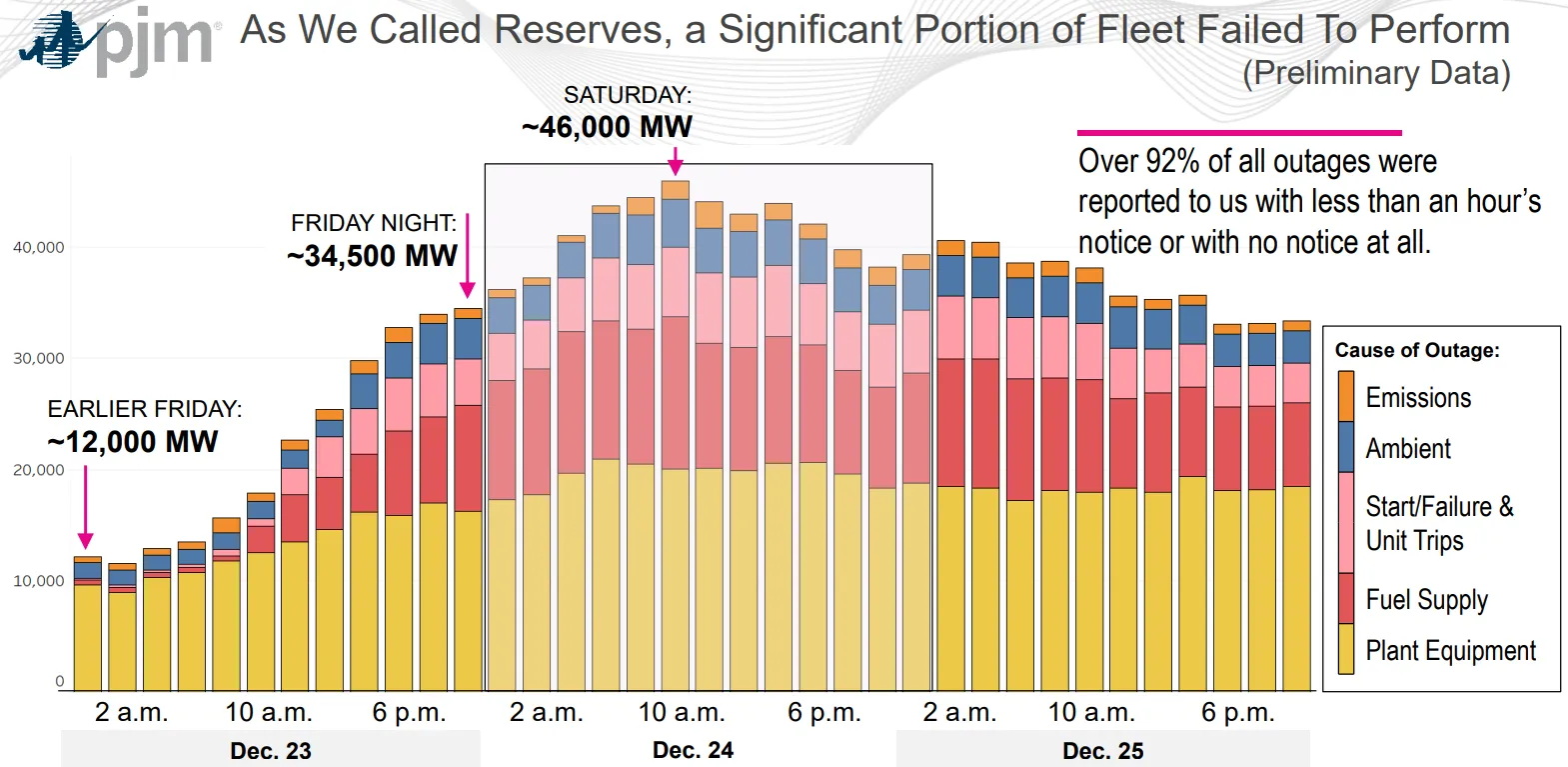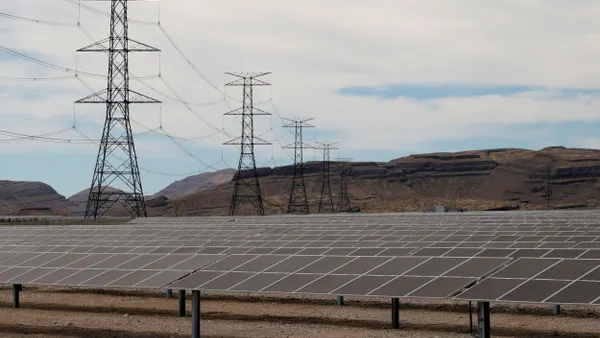Dive Brief:
- Power plant owners in the PJM Interconnection may owe $1 billion to $2 billion for failing to provide electricity during Winter Storm Elliott in late December, according to an initial estimate released Wednesday by the grid operator.
- About 45,950 MW, or 23.2% of PJM’s generating fleet, was unexpectedly offline on Dec. 24, mainly because of plant equipment that didn’t operate and fuel supply problems, Donnie Bielak, PJM senior manager for dispatch, said during a presentation to the grid operator’s Market Implementation Committee. Gas-fired generation accounted for 70% of the unplanned outages, he said.
- The poor performance by gas-fired generators could lead to political fallout, according to ClearView Energy Partners. “Natural gas generators have often argued that they are more flexible and more reliable – particularly when intermittent renewables and/or storage may not be available in the case of protracted system stress,” the research firm said Wednesday. “Broad underperformance could provide contradictory evidence for such assertions.”
Dive Insight:
PJM was prepared for Winter Storm Elliott, which brought record-setting low temperatures to parts of the East Coast for a roughly three-day period starting on Dec. 23, according to Bielak.
The grid operator issued a cold weather advisory for its Western region on Dec. 20, followed by a cold weather alert for the region a day later and another alert for its entire footprint on Dec. 23. PJM operates the grid from New Jersey to Illinois.
Based on generator availability data it received from power plant operators, PJM thought it had a 29-GW reserve for Dec. 23, up from a typical 3-GW reserve, according to Bielak.
Electric use that day was about 10% higher than forecast and power plants failed to operate as expected, he said. Besides the 46 GW that failed to run on Christmas Eve, 6 GW of mainly gas-fired steam generation failed to come online when called on by PJM and the grid operator lacked electricity to refill pumped storage hydroelectric reservoirs overnight that would have normally provided power the following day, Bielak said.
“Generation outages were unacceptably high and they occurred at the worst possible times for system operations,” Bielak said. “A large portion of our generation fleet failed to do what was required of them.”

More than 92% of the power plant outages were reported to PJM with less than an hour’s notice and in some cases no notice, according to Bielak.
The grid operator avoided rolling power outages, partly by asking people to reduce their electricity use and through an emergency waiver from the Department of Energy that allowed some generating units to exceed their emissions limits, Bielak said.
During the winter storm, PJM continued to import and export power. Exports peaked on Dec. 23 to support the Tennessee Valley Authority and other areas, but declined as PJM experienced power plant outages, Bielak said. PJM was a net importer during part of Christmas Eve.
PJM plans to release the results of its investigation into its operations during the winter storm in mid-April. Officials intend to meet with power plant operators to get more information about why there were so many plant outages.
The power plant outage rate during the winter storm was higher than during the Polar Vortex in 2014, which led to the PJM’s capacity performance framework, according to Mike Bryson, PJM senior vice president for system operations.
PJM’s capacity performance framework is designed to improve power plant performance by fining generators that fail to deliver electricity during emergencies and paying extra to those that exceed their power delivery requirements.
Power plant owners that fail to pay non-performance penalties will lose their PJM membership, officials said.
PJM plans to release preliminary performance data in the first week of February. The penalties will be included in March bills.
During the meeting, Bryson called for a tougher reliability standard for weatherizing power plants than the one pending at the Federal Energy Regulatory Commission. It should also be put in place sooner than planned, he said.
The Natural Resources Defense Council called for market rule changes to improve power plant performance during extremely cold weather.
“History has proven again and again that gas is not as firm as it claims to be, and reliability will continue to suffer until that fact is accepted,” Tom Rutigliano, NRDC senior advocate, said in a statement.
PJM’s year-round capacity market was designed to meet high demand during the hottest summer days, but is struggling to meet winter needs, according to Rutigliano. It should be split into seasonal markets that focus on each season’s unique challenges, he said.
“FERC needs to take a serious look at how the industry is preparing for cold weather and find the political will to set binding winterization standards, including on natural gas supply,” Rutigliano said. “PJM and FERC need to fix market structures that reward unreliable power plants.”
PJM Power Providers Group, a trade organization for generators, expects rule changes in response to Winter Storm Elliott, according to Glen Thomas, P3 president.
“However, P3 fears events like this could become more frequent and severe if PJM and FERC do not support adjustments that ensure generators have pathways to be compensated for the costs and risks associated with providing the reliability that is envisioned by PJM's capacity design,” Thomas said in an email.













